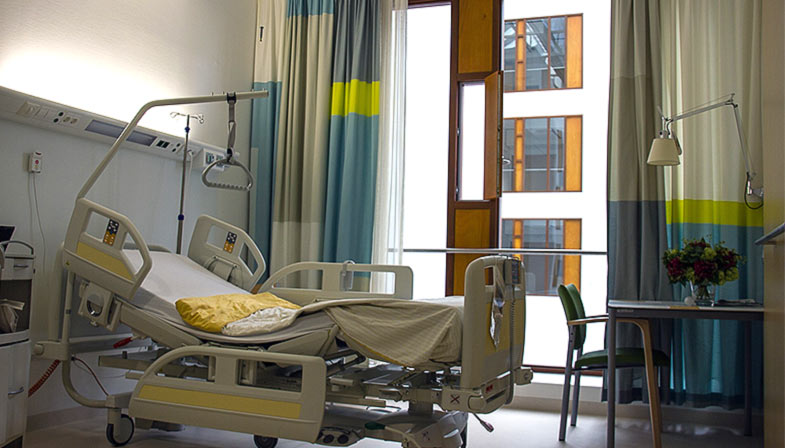 Not all kids can come to the hospital’s classroom and that means going to the child’s room to do hands-on science. A child’s situation can be such that interacting with other patients isn’t tenable for a variety of reasons. The child could be susceptible to infections or be infectious. Many times, the kid can’t physically leave the bed or room due to the realities of recovery or a result of receiving treatment. Bringing science to the kid is colloquially known as a “bedside,” because the child is in their bed and you’re using their hospital overbed table (the one they eat lunch on) to do science. But a lot of kids, who are mobile, can move about the room. At the Oakland Children’s Hospital, they have windowsill couches that are perfect for doing science. You’ll need to get the classroom staff’s impression on how mobile the kid is, and when you arrive, talk with the kid and/or parent before setting up to see what they prefer. The classroom staff has a “census” and throughout the morning, they’ll go around and talk to kids and gauge their interest in doing science. They’ll give you a list of rooms to visit and tell you what restrictions the kid may have.
Not all kids can come to the hospital’s classroom and that means going to the child’s room to do hands-on science. A child’s situation can be such that interacting with other patients isn’t tenable for a variety of reasons. The child could be susceptible to infections or be infectious. Many times, the kid can’t physically leave the bed or room due to the realities of recovery or a result of receiving treatment. Bringing science to the kid is colloquially known as a “bedside,” because the child is in their bed and you’re using their hospital overbed table (the one they eat lunch on) to do science. But a lot of kids, who are mobile, can move about the room. At the Oakland Children’s Hospital, they have windowsill couches that are perfect for doing science. You’ll need to get the classroom staff’s impression on how mobile the kid is, and when you arrive, talk with the kid and/or parent before setting up to see what they prefer. The classroom staff has a “census” and throughout the morning, they’ll go around and talk to kids and gauge their interest in doing science. They’ll give you a list of rooms to visit and tell you what restrictions the kid may have.
But I’m getting ahead of myself, if you arrive at a child’s bedside unprepared for the realities of the situation, you will waste a lot of time and resources. So let’s talk about logistics. In terms of preparing activities, you’ll need to bring enough content to cover about 15 to 20 minutes with the kid. However, you’ll probably spend about 10-15 minutes either prepping or sanitizing your activity afterwards. In total, it takes about 35-40 minutes to do a bedside, which means you’ll only see about 3 kids for every two hours of time you have. You only need to bring 2 or 3 activities and this allows you to be a lot more creative/flexible in how you present the content to different ages/ability. And don’t forget, you might have a parent/guardian present to offer support, too.
Being properly prepared is a real challenge as you’ll need to bring the absolute minimal amount of material to successfully carry out the activities. And, the materials need to be either new, disposable, and/or easily sanitized and you may need to review with the classroom staff the materials you’re bringing, just in case. You don’t want to bring too much material because 1) you’re carrying it to the kid’s room, 2) you don’t have a lot of space to do the activity(s), and 3) when you come back from the kid’s room, you need to dispose of or sanitize EVERYTHING that went with you. If you bring too much, you waste a lot of time sanitizing objects you never used or throwing away perfectly good, but not sanitizable material. You want to bring the minimal amount without compromising the experience so don’t forget the important parts of your activity! Proportioning the activities beforehand helps tremendously. Can you pre-assemble part of your activity? Do you really need to bring every marker color? The entire box of baking powder? The classroom should have plastic baggies and disposable containers so take advantage of those before leaving for a bedside. As the day goes along, you need to reflect on what you brought with you and what you really need to be successful. If you can get your turnaround time to 30 minutes total, you’re doing pretty good!
One logistical aspect of doing bedsides really surprised me: water is readily available! Every room should have a sink and if you’re doing activities with water, like ACS’s Polishing Pennies, NISE’s Thin Films, Gummy Capsules (which is a great activity to talk about how medicine can be made), Gravity Fail, Nano Fabrics and Lotus Leaf Effect, you have easy access to it. Just don’t spill it in the kid’s bed! You should also have access to a moveable table that’s normally used for eating meals in bed: you may need to ask the parent to help you clear it off. You should also have a chair for yourself because doing a bedside while standing is awkward.
If you plan accordingly, you can minimize downtime, reduce waste, and reach more kids. The more you do bedside activities, the better your editorial process for deciding which materials to bring will be. My next post will stay on the subject of bedsides because there is more involved than the logistics that I just discussed.
Coming Soon: Doing Science at the Bedside (Part 2)
